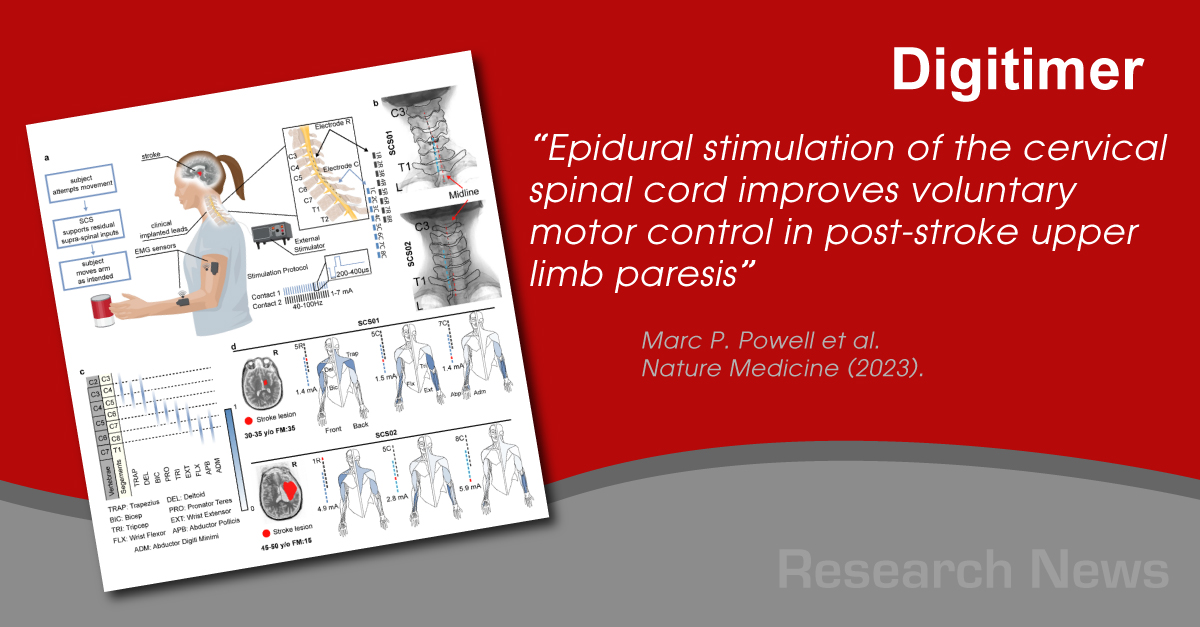Research News
Digitimer DS8R Stimulator & D188 Electrode Selector Facilitate Ground-breaking Stroke Recovery Research
New research published this month in Nature Medicine demonstrates how epidural spinal cord stimulation can restore arm and hand mobility in stroke patients, allowing them to undertake normal daily activities that would otherwise have been impossible. The findings of this multi-centre collaboration have led to intense global media interest, as the results may pave the way for the mainstream treatment of chronic stroke symptoms, including paresis.
Researchers based at institutions including Pittsburgh and Carnegie Mellon Universities speculated that voluntary motor control could be regained by enhancing the capabilities of the damaged corticospinal tract (CST). Previous studies have demonstrated the power of spinal cord stimulation in patients with spinal cord injuries and several international research groups and commercial organizations are carrying out advanced research in this area. The authors considered that it would be worthwhile examining how electrical stimulation of the CST might modulate the excitability and responsiveness of surviving neurons within the tract.
Abstract
Cerebral strokes can disrupt descending commands from motor cortical areas to the spinal cord, which can result in permanent motor deficits of the arm and hand. However, below the lesion, the spinal circuits that control movement remain intact and could be targeted by neurotechnologies to restore movement. Here we report results from two participants in a first-in-human study using electrical stimulation of cervical spinal circuits to facilitate arm and hand motor control in chronic post-stroke hemiparesis (NCT04512690). Participants were implanted for 29 d with two linear leads in the dorsolateral epidural space targeting spinal roots C3 to T1 to increase excitation of arm and hand motoneurons. We found that continuous stimulation through selected contacts improved strength (for example, grip force +40% SCS01; +108% SCS02), kinematics (for example, +30% to +40% speed) and functional movements, thereby enabling participants to perform movements that they could not perform without spinal cord stimulation. Both participants retained some of these improvements even without stimulation and no serious adverse events were reported. While we cannot conclusively evaluate safety and efficacy from two participants, our data provide promising, albeit preliminary, evidence that spinal cord stimulation could be an assistive as well as a restorative approach for upper-limb recovery after stroke.
Stimulation Methods
Electrical stimulation was delivered by the Digitimer DS8R stimulator with our D188 Remote Electrode Selector used to direct stimuli to arrays of epidural electrodes located in the cervical spine. Employing a MATLAB-based GUI, the authors were able to precisely control the DS8R and D188 via an Arduino micro-controller connected to the PC using a virtual serial port. The GUI allowed for pulse amplitude, timing, and electrode selection to be tightly coordinated.
Parameters controlled by the software included, pulse duration, inter-pulse interval, amplitude and waveform shape. Specifically, the DS8R was set to deliver a cathodic first, biphasic waveform with 200µs or 400µs phase duration and 10µs interphase interval.
Although the DS8R is a single-channel device, the authors employed the D188 as a multiplexer to deliver semi-synchronous stimulation to multiple channels.
Motor Control Recovery Research After Paralysis
25% of adults over 25 years old are likely to suffer from a stroke in their lifetime and 75% of those will have lasting deficits in motor control, so research of this type is critically important for global health.
In the video, Marco Capogrosso, director of the University of Pittsburgh Spinal Cord Stimulation Laboratory and co-senior author of this study provides an insight into the latest research into spinal cord stimulation for the recovery of motor control after paralysis.
Summary
Although limited in size, the study elegantly demonstrates that electrical stimulation of the CST may indeed have benefits for stroke patients who are suffering from debilitating movement restrictions. Continuous stimulation allowed participants to accomplish movements they had been unable to achieve for years. Notably, these effects seem to persist in the absence of stimulation, which may indicate this technique could have a restorative and assistive role to play in stroke recovery.
The authors plan to extend the trial to further patients and investigate whether the stimulation protocols may be further optimized to enhance their effects. The University of Pittsburgh and Carnegie Mellon University have formed Reach Neuro, a start-up company whose aim will be to translate this ground-breaking research into a clinical treatment.
The Digitimer DS8R stimulator, pictured opposite, was developed with financial support from Innovate UK and it is immensely rewarding to see how our most advanced electrical research stimulator is now being used in cutting-edge human neuroscience research targeted at improving the health of millions of stroke victims worldwide.
Reference
Powell, M.P., Verma, N., Sorensen, E. et al. Epidural stimulation of the cervical spinal cord for post-stroke upper-limb paresis. Nat Med (2023).
https://doi.org/10.1038/s41591-022-02202-6
Find Out More
If you would like to find out more about the Digitimer DS8R Stimulator or D188 Remote Electrode Selector, used in this study, then please do not hesitate to contact us or our local representative.
The Digitimer DS8R and D188 are not medical devices and are marketed and intended for human research applications.




